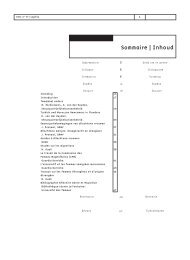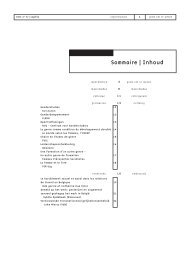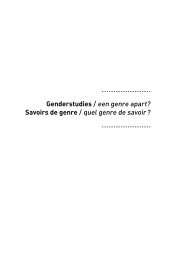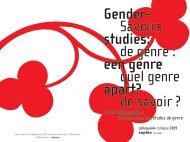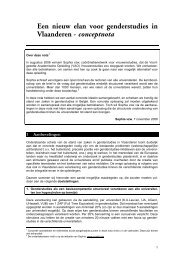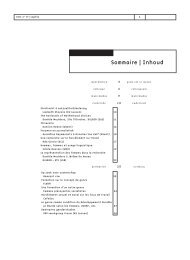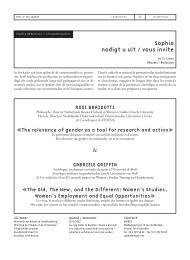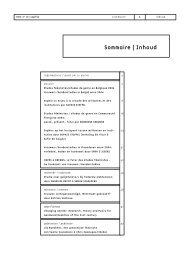Create successful ePaper yourself
Turn your PDF publications into a flip-book with our unique Google optimized e-Paper software.
it, ‘is “bi”-directional: it theorizes from bottom to top and top to bottom’. 26 This raises the question of the<br />
relationship between ‘queer’ and ‘theory’, especially as it relates to the Dublin Queer Studies Group, many<br />
of whom took issue with what they saw as the exclusionary language and elitist posturing of queer theorists.<br />
That is why I use the word ‘quare’ in connection with ‘theory’ because it points to the discussions we<br />
were furiously having early in the new Millennium. 27 It is at the point of those unresolved – sometimes irreconcilable<br />
– tensions that quare theory can be identified, as well as in the perverse pleasure that we took<br />
in challenging one another’s conceptions of self, desire and identification.<br />
Critically <strong>Quare</strong><br />
‘Queer’ is such a simple, unassuming little word. Who ever could have guessed that we would come to saddle<br />
it with so much pretentious baggage – so many grandiose theories, political agendas, philosophical<br />
projects, apocalyptic meanings? 28<br />
If the term ‘queer’ is to be a site of collective contestation, the point of departure for a set of historical<br />
reflections and futural imaginings, it will have to remain that which it is, in the present, never fully<br />
owned. 29<br />
This section commences with a consideration of the usefulness of employing the term quare to refer to<br />
an analytical process, after which I briefly offer a few suggestions as to how quare theory might function<br />
as a critical process for examining the affective investment, embodied practices and performative machinations<br />
involved in doing queer theory in Ireland.<br />
Critically <strong>Quare</strong><br />
« Queer » est un petit mot si simple et si modeste. Qui<br />
aurait pu deviner que nous y accrocherions tant d’appelthrough<br />
a feminist and lesbian studies lens and vice versa.”<br />
hoge vlucht neemt. Volgens de formulering van E. Patrick<br />
Johnson zijn ‘quare studies’ ‘bi’-directioneel: de theorie<br />
wordt opgebouwd van onder naar boven en van boven naar<br />
onder.’ 26 Dit doet de vraag ontstaan naar de relatie tussen<br />
‘queer’ en ‘theorie’, vooral in verband met de Dublin Queer<br />
Studies Group, waarvan vele leden het oneens waren over<br />
wat ze zagen als de uitsluitende en elitaire stellingname<br />
van queer theoretici. Dat is waarom ik het woord ‘quare’<br />
gebruik in verband met ‘theorie’, omdat het verwijst naar<br />
de vurige discussies die we hebben aan het begin van het<br />
nieuwe millennium. 27 Het is op het punt van deze onopgeloste<br />
– soms onverzoenbare – spanningen dat quare theorie<br />
kan worden geïdentificeerd, alsook in het perverse plezier<br />
dat we hadden om de opvattingen die ieder had van<br />
zichzelf, begeerte en identificatie hadden.<br />
Kritisch quare<br />
‘Queer’ is zo’n eenvoudig, bescheiden woordje. Wie had<br />
ooit gedacht dat we het met een dergelijke pretentieuze<br />
betekenis zouden beladen – zo veel grandioze theorieën,<br />
politieke agenda’s, filosofische projecten, apocalyptische<br />
betekenissen? 28<br />
Als de term ‘queer’ een plek van collectieve strijd is, het<br />
vertrekpunt voor een aantal historische reflecties en futuristische<br />
voorstellingen, zal hij moeten blijven wat hij is,<br />
in het heden, nooit volledig bezeten. 29<br />
Dit onderdeel begint met een overweging of het nuttig<br />
is de term quare te gebruiken om naar een analytisch<br />
proces te verwijzen, waarna ik kort een aantal suggesties<br />
geef over het gebruik van quare theorie als kritisch proces<br />
om de affectieve investering, belichaamde praktijken en<br />
performatieve machinaties in verband met de uitoefening<br />
van queer theorie in Ierland, te onderzoeken.<br />
William Haver merkt op dat ‘het nuttiger zou zijn om<br />
te vragen wat queer onderzoek doet, te vragen wat er gebeurt<br />
in queer onderzoek, dan te vragen wat het is.’ 30 Dit is<br />
een strategie die in de praktijk wordt gebracht door queer<br />
theoretici die niet graag worden gedefinieerd of gecatagories<br />
de personnes, qui affichaient parfois des opinions<br />
fondamentalement opposées et nous obligeaient tous à<br />
essayer de trouver un terrain d’entente commun où nous<br />
pourrions tolérer, sans pouvoir toujours comprendre, des<br />
points de vue radicalement différents.<br />
Ce fut à l’occasion du Dublin Queer Studies Group<br />
qu’apparurent les frontières entre les formes particulières<br />
du féminisme (lesbien) et de la théorie queer sont devenues<br />
visibles alors que les participants mettaient parfois<br />
en avant des pensées opposées sur des sujets tels que le<br />
transsexualité, la bisexualité, l’hétérosexualité, la capacité<br />
et l’identification. De nombreux débats restaient sans<br />
réponse, les participants se confrontant à un gouffre d’hypothèses,<br />
d’incompréhensions et de convictions politiques<br />
en opposition. C’est dans ce gouffre, aux frontières entre<br />
les identités et les identifications, que la théorie quare<br />
apparaît et prend son envol. Selon E. Patrick Johnson,<br />
« les études quare », comme il les dénomme, « sont “bi”-<br />
directionnelles : elles théorisent du bas vers le haut et du<br />
haut vers le bas » 26 . Ceci soulève la question de la relation<br />
entre « queer » et « théorie », en particulier concernant le<br />
Dublin Queer Studies Group, dont de nombreux membres<br />
étaient en désaccord quant à leur conception de la prise<br />
de position exclusive et élitiste des théoréticiens queer.<br />
C’est pourquoi j’utilise le terme « quare » en rapport avec<br />
« théorie » parce qu’il attire l’attention sur les discussions<br />
houleuses que nous avions précédemment eues au début<br />
de ce nouveau millénaire 27 . C’est au point culminant de<br />
ces tensions irrésolues – parfois irréconciliables – que la<br />
théorie quare peut être identifiée, mais également dans le<br />
plaisir pervers que nous prenions à défier les conceptions<br />
des uns et des autres du moi, du désir et de l’identification.<br />
19




